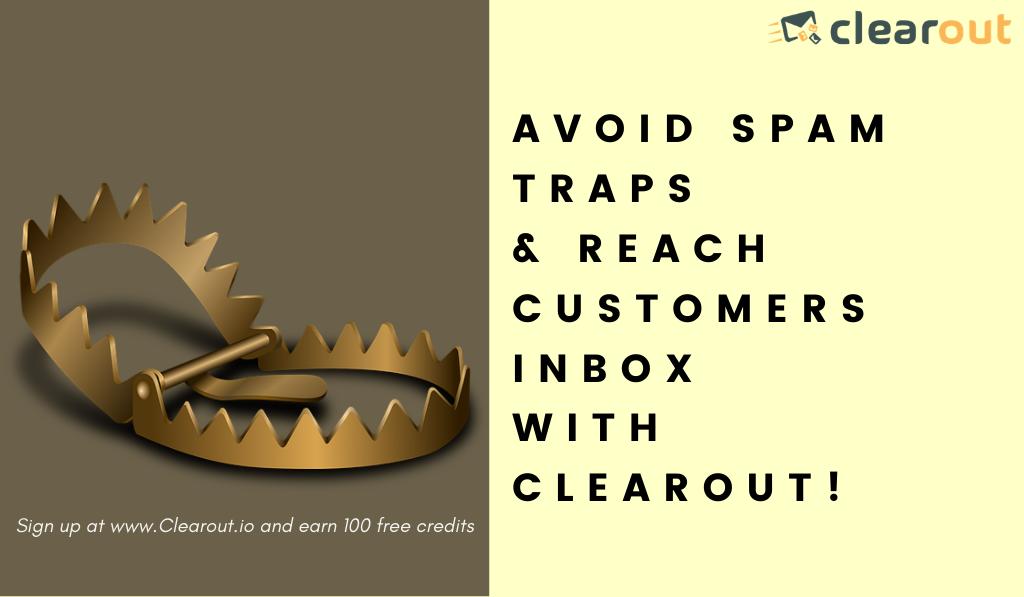Spam traps, also known by the name honeypots, are a fraud management tool used by ISP’s (Internet Service Protocols) and blacklist providers to identify and block the emails from spammers and keep the emailing system clean. It’s an email address that looks real but is set out only to detect those who send spam emails and cannot be used for real communication.
No one wants spam traps in their email lists as
-
They affect your sender reputation due to which your emails end up in spam folder
-
They ruin your email deliverability abilities and increase the bounce rates
-
They can even get you blacklisted
Types of Spam Traps
The spam traps are created in different ways and there are chances you may hit a spam trap unknowingly.
-
Pristine/pure spam traps - These are fresh email addresses, created by ISPs and other organisations, and have never been used by a sender. Such email addresses are embedded in websites so whenever a spammer scrapes websites to grow their contact list these spam traps end up in their lists. Such spam traps can be easily found on purchased or rented lists too. When the ISPs notice any sender sending emails to the pristine spam trap they conclude the use of suspicious methods for gathering contacts. The pristine spam trap causes the most severe damage to sender reputation and can lead to permanent blocking of the domain and IP address.
Tip: Avoid purchase or rented lists. Do not add people to your email list without their agreement. Use the double opt-in method to confirm the user’s interest towards your emails.
-
Fake/Invalid email addresses - People can subscribe to your email list using a fake email address voluntarily or may misspell the email address unintentionally. There is a risk of spam traps with such email addresses and while you are delighted about the growing email list, there is always a possibility of your email hygiene getting worse!
Tip: Double opt-in and a regular verification of email lists can not only minimize the involvement of spam traps in your email database but it’s going to increase the open and click-through-rates too.
-
Recycled email addresses - Remember your first email address which was the combination of your name and date of birth? I am sure you must have abandoned it a long time ago! Probably now it is being used by your provider as a trap to identify the spammers. Such spam traps can be tricky as they might have been valid when collected years ago but repurposed to attract spammers.
Tip: Keep your lists up to date by removing inactive subscribers regularly and managing bounced emails.
Consequences of reaching a spam trap
Spam traps can work in mysterious ways so there may not be any fixed response. For example
-
The emails may bounce telling you that you have hit a spam trap - This is bad for the success rate of you email marketing campaigns but ideal to make you aware of the existent spam traps in your list that gives you a possibility to remove them.
-
The emails may bounce with a message ‘User does not exist’ - in such cases the emails may bounce back without giving any specific reason. To avoid getting blacklisted ensure the bounce rate is within the industry limits. A regular email verification using highly accurate email verifier can keep the bounce rates low.
-
No consequences - There are times when sending emails to spam traps has no consequence, it acts like a normal email and there is no bounce back. You may feel relieved but how can you remove an enemy if you’re not even aware of its presence.
Ignoring spam traps can bring consequences that any email marketer will regret like - suspension of ESP account, damage to sender reputation leading to redirection of your emails to spam folder, getting blacklisted by ISP removal from which can be time-consuming.
How to prevent spam traps from entering your email lists?
Poor email list management is one major source for spam traps to enter the email lists which can be prevented by maintaining a healthy contact lists by following these practices
-
Take measures to avoid contamination in list building
A list is contaminated if an email address, that is a spam trap, is added to the list deliberately or unintentionally. To avoid list contamination integrate a highly accurate email verifier into your sign-up/registration forms to check the legitimacy of an email address and avoid losing a genuine user due to typos. In addition, use double opt-in for all the subscribers as it gives them a chance to confirm their email address before you start sending them your content.
-
Regular clean-up of existing email list
As mentioned earlier, sometimes spam traps are sourced from outdated email addresses that are no longer valid. This calls for a regular clean up of your lists to keep it up to date with subscribers who regularly engage with your content. Take the following steps to maintain a healthy list
-
Verify your email lists regularly with an accurate and efficient email verification tool to remove invalid, catch-alls, disposables and other email addresses that have gone inactive
-
Once the email ist is verified send a re-engagement campaign to the remaining subscribers
-
Eliminate subscribers who do not respond to the re-engagement campaigns to swipe off any contacts that can possibly be a spam trap.
-
Avoid purchasing lists
Believe it or not, a purchased list is a house of all kinds of unwanted email addresses like -
Invalid, duplicates, disposables, spam traps, unknowns and catch-alls too. Those selling the data are not quite concerned with the quality of contact list or if it is ideal for your business or not. In 95% of the cases, the seller does not guarantee the performance of the list and in the end it turns out nothing but a lousy idea with wastage of money.
How does Clearout detect spam traps?
Clearout email verification service performs 20+ validation checks on each email address and predicts the likelihood that an email will be opened by active addresses. The scoring process makes you aware if an address has not engaged with a single message over a long period of time so you may filter out such email addresses which may become inactive in future and get recycled into spam traps.
A spam trap created by recycling an existing email address will most likely bounce that too as a hard-bounce which is not good for either your email deliverability rates or sender reputation.
However, Clearout uses its algorithms and monitors the trends of millions of contacts to predict the likelihood that an email address may return as a hard bounce.
Clearout’s API integration to your website for registration forms validates email addresses on a real-time basis ensuring only valid email addresses to enter your email lists but parallely it is important to focus on organic address acquisition and regular list cleaning of the existing data as well.
Before concluding , I would like to make you aware of the fact that the content of the emails play an equally important role in maintaining your sender reputation and letting the ISPs decide whether your emails are suitable for the inbox or not.
Here are a few tips you should never forget while creating the email content
-
Personalize your emails.
-
Keep rephrasing the template content.
-
Use a real reply-to address, avoid bots
-
Be aware of spammy phrases, avoid using them anywhere.
-
Keep the content and subject line short and to the point.
-
Avoid using too many images.
-
Include an “Unsubscribe” Link
Here are a few customer service email templates for your reference.
Conclusion :
Long story short, avoid spam traps and improve your email deliverability by using the best email validation and verification tool & don't forget to have a quality content in place in your email templates.








